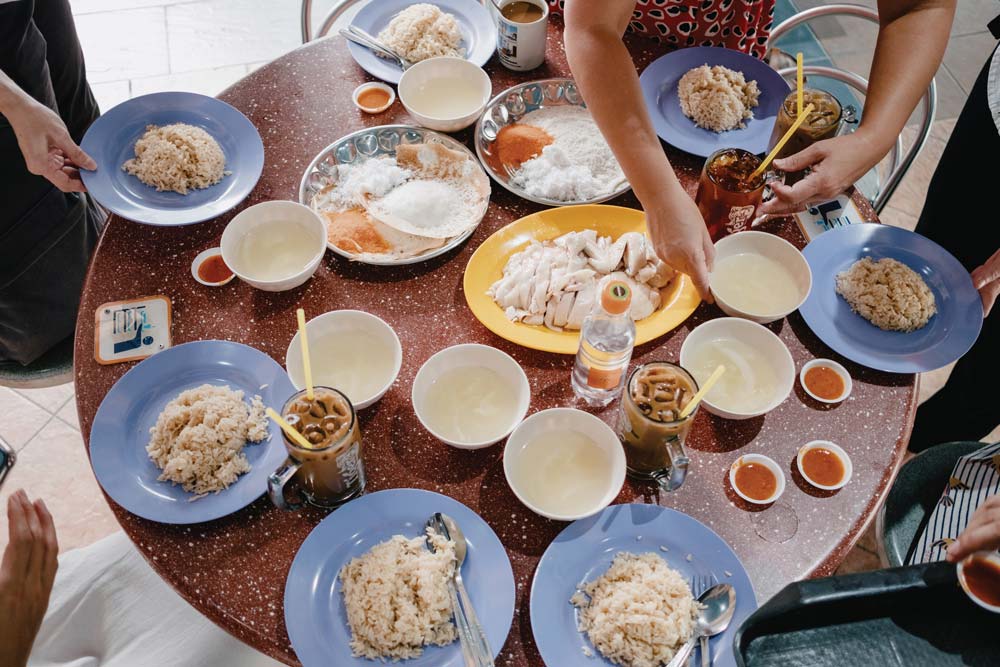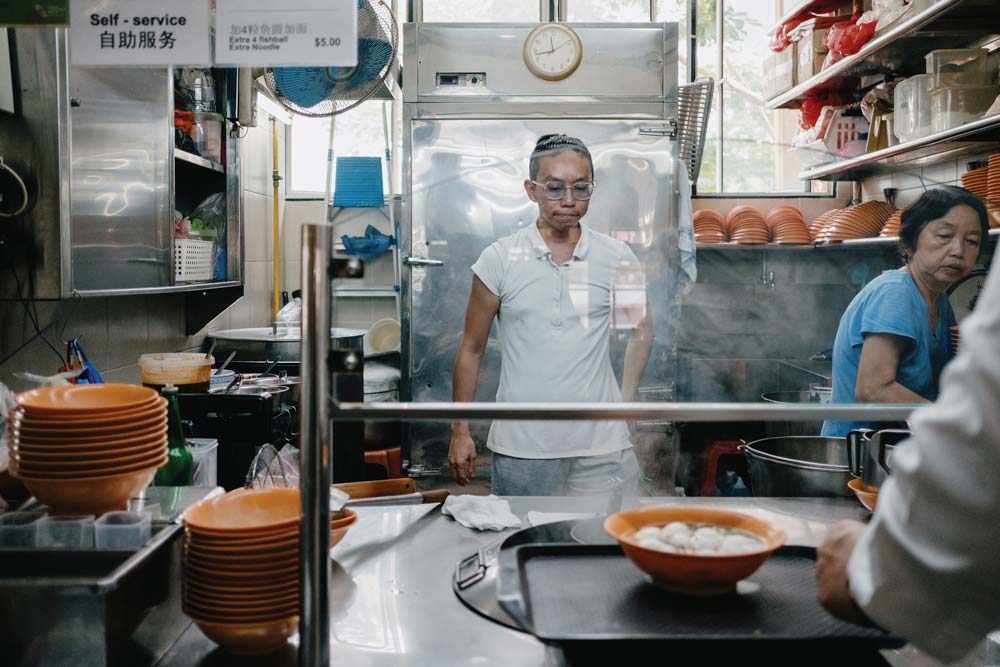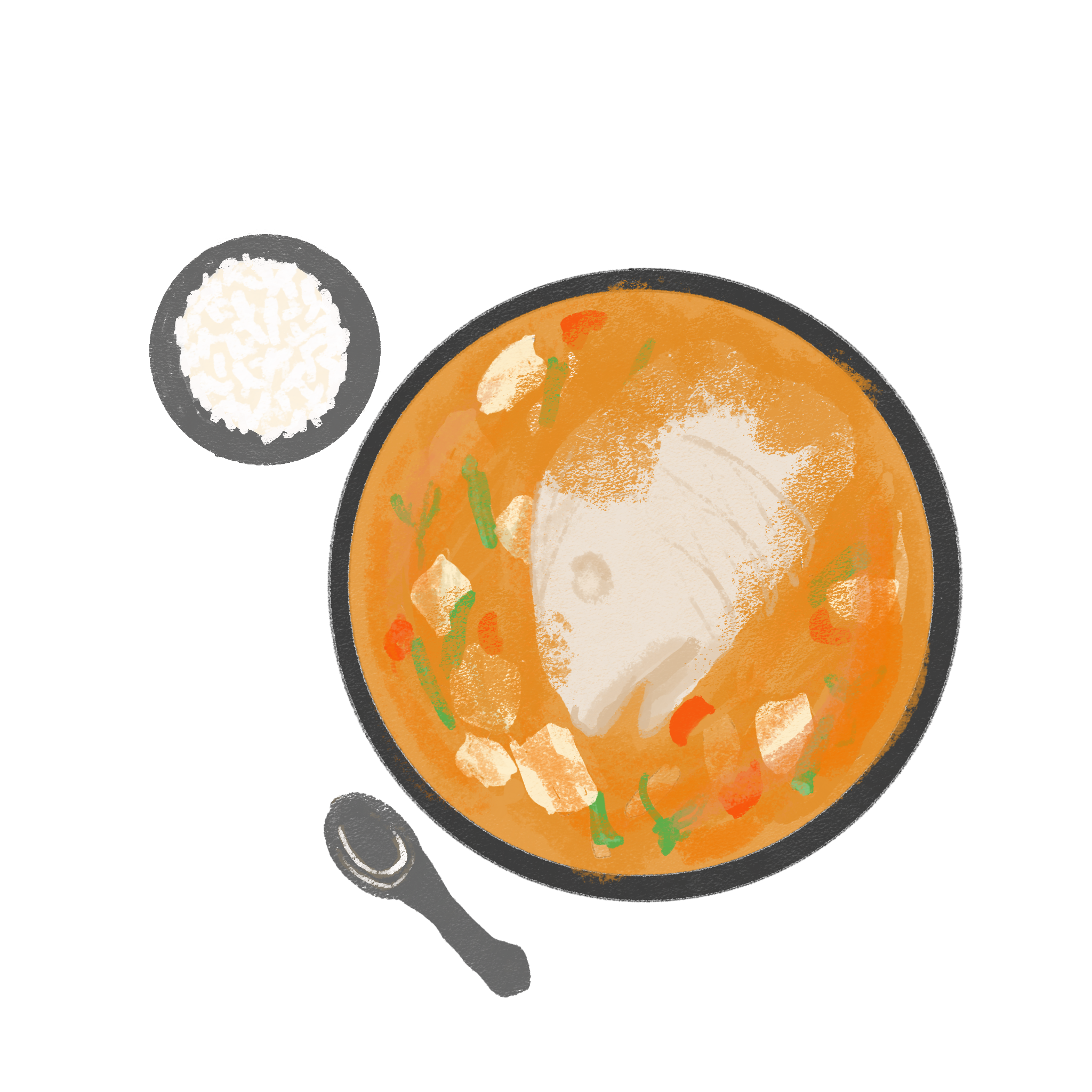The State of Street Fare

As Singapore’s iconic food hawkers age, an uncertain future awaits
Long lines form at the 114 public hawker centers throughout the day and long into the night in Singapore. Crowds of seniors, office workers and even visiting chefs queue up for the fried carrot cake, curry fish head, oyster omelette, sweetened shaved ice and other favorites.
With plates costing $3 apiece, there isn’t a better food bargain to be found and the dishes are influenced by Chinese, Malaysian and Indian cuisines. Such an array in food reflects the city-state’s own cultural diversity and rich tradition. Standing amid one of the open-air markets, breathing in the aromas, it’s difficult to believe that this vibrant food scene, which unites Singaporeans and has become a huge part of their national identity, may face a tenuous future.
As one wanders among the food stalls, it seems everyone has an opinion about which food is best and sure to enthrall any customer. The food, personalities and banter have made the hawker scene a communal dining room.
“This, if you like food, might be the best place on earth,” Anthony Bourdain once said on his TV series “No Reservations.”
From his stall in the Mei Ling Hawker Centre, Chip Ang sells chicken rice, one of Singapore’s signature street dishes. While hundreds may await his fare daily, Ang says, “The hawker culture is not easy.”
Steep startup costs, long hours and even the reluctance of experienced hawkers to help newcomers enter the industry are major factors that threaten this way of life, no matter how long today’s lines may be. A government study in 2017 found that the average age of Singapore hawker was 59 years old and how well this tradition is handed from one generation to another could well determine the future for hawking.
Singapore has been described as a food paradise and the hawker centers are the city-state’s most visible symbol of what the Gastro Obscura website calls a “highly democratic culinary scene.” Its origins date back to the mid-1800s when street vendors would work from carts and hawking became a viable career for many by the late 1950s. The region was rebuilding after World War II and within a decade nearly 25,000 hawkers were plying their trade. After regulations led to better hygiene and site location, the hawker centers increased in popularity throughout Singapore. Their offerings won raves, for price and quality, with Chan Hon Meng’s soya sauce chicken rice garnering a Michelin Star in 2016.

Today, though, newcomers sometimes find themselves at a competitive disadvantage to the established hawkers. The latter can pay less for their food stalls—a legacy of government action a half-century ago that moved businesses off the streets and into the centers. Today, it takes approximately S$40,000 to open a hawker stall, which includes apprenticeship fees.
“It’s a family business, but it’s hard work,” says Grey Yeo, a third-generation hawker from the Xin Lu Fish Ball Soup stall. “And money to be paid? So many things before they can start a business.”
A typical working day for a hawker begins well before dawn and typically runs well into the evening. Many hawkers only take one day off a week, with most awake and setting up the stalls or shopping by 4 a.m. When stall operations end, set up for the next day can run until 9 p.m.
To make ends meet, hawkers usually need to target two or the three meals a day. For Rodney Sung, it’s breakfast and lunch. Two years ago, he opened a food stall specializing in popular bread and pastries called Mr. Bready with partner Jason Hia, who graduated from Caltech.
“It’s a waiting game for bread-making,” Sung says. “Once we miss the breakfast timeline, then we miss the clock.”
In a market saturated with bakeries, Sung and Hia turned to innovation. In essence, putting a modern twist on things. They added premium Japanese flour for such specialties as chocolate-themed cake. In doing so, they gained a solid following as their business became all consuming.
“We have no time for our family and friends,” Sung says. “For us, we’re just two people. We have to do everything.”
Sung, 36, and Hia, 30, are millennial hawkers—often a rarity in today’s marketplace. Some their age are reluctant to take up hawking. Instead, striving to be an executive, with 8-to-5 workdays, carries more prestige, especially with family.
“Many of the young hawkers come into the trade, and after two, three years, they decide to give it up,” Ang says. “Go back to corporate work.”
Ang’s parents went as far to warn him not “to go into the food business. ‘You have to be an engineer, a doctor or lawyer.’”
Sometimes would-be hawkers can be stymied by prevailing attitudes within the industry. The more experienced cooks may pay less for their stalls, but some are reluctant to pass along recipes and tips to the next wave. So, as older hawkers retire, there are fewer new cooks ready to take their places. Without successors, such favorites as loh kai yik (stewed chicken wings) and yi buah (rice cakes with coconut fillings) may not be available, no matter the demand.
Some veteran hawkers refuse to pass along their cooking secrets unless they are followed to the letter. Tradition can be paramount for soups and rice dishes. If a newcomer dares to innovate, the experienced cook who passed the recipe along can be feel slighted, Ang says.
“Many of them may not be ready to pass on the skills to someone,” he adds. “‘This belongs to me and I only pass it to my children.’ That’s why many of our traditional foods may disappear.”

“I don’t mind coming to work. When I’m at home, there’s nothing to do, so I’d rather be here. I plan on continuing to work until I can’t anymore.” Low Siew Tiang, age 62
After spending three decades raising her children and grandchildren, Low decided to return to the workforce. All three of her brothers are hawkers and she worked in a food stall many years ago, so she is familiar with the industry. She now works at Sin Kee Chicken Rice, helping to prep the food and clean the kitchen. Her day begins at 7am and ends around 3:30pm.

“We’re standing up to retain the philosophy of our business. We’re not selling fish. We’re selling memories.” Grey Yeo, 40
Yeo is a third-generation hawker. His grandfather originally sold barbecued fish in the streets and when the government built the hawker centers, the family relocated their enterprise indoors. Though Yeo is trained as a graphic designer he decided several years ago to work for the family business, Xin Lu Teochew Fishball Noodles.

“I’m selling tradition with my chicken rice. I want to keep the tradition and I’ll never change the recipe. It’s up to the young people to innovate. But my generation, we’d rather keep it the way it’s been for the past 40 years.” Lau Chiew Hua, age 58
Lau spent his career working in food stalls, starting when he was 18 years old. For that entire four-decade span, he has focused on perfecting just one meal: chicken rice, Singapore’s national dish. He recently passed down the recipe and technique to his 23-year-old son, who plans on opening a food stall. Lau thinks he will likely retire within the next three to five years.
In addition, the policy at some hawker centers stipulates that only Singaporeans and permanent residents can work the food stalls. Again, newcomers and outsiders may not receive a full opportunity to try their hand at hawking.
Costs for operating a stall can also vary widely. Some original owners, thanks to government help, may pay only S$300 a month at a center, while recently established hawkers, such as Ang and Yeo, can pay S$1,000 or more to operate a food stall.
“Government always tells the hawker, ‘Keep cost low.’ But everything is going up,” Ang says. “The vegetable price, the electricity price, the transport prices, everything is going up. The government needs to think that if you want to tell the hawker to keep cost low, can you sell them subsidized water or electricity?”
In a world of increasing globalization, some hawkers wonder if there will continue to be demand for their traditional dishes. Despite today’s lines, they are concerned that Singapore’s newer food courts, where one can find McDonald’s and other international chains, are growing more popular with younger customers. Ang says he has difficulty winning over his own children. Instead of going to the hawker center to eat, they would rather visit one of the air-conditioned food courts to order ice cream or Mickey D’s.
In recent years, several major initiatives were begun to help hawkers of all ages. The government started an incubation program to match younger cooks with older hawkers who are nearing retirement. Successful applicants are offered subsidized stall rentals for 15 months. The stalls will come with basic equipment to lower the upfront capital investments.

More experienced hawkers will be helped with social media and utilizing food delivery apps. Until recently, hawker centers only had two choices – eat here or take out. Now ways are being explored about how best to deliver to homes and offices, and to help hawkers receive electronic payments. Also, 10 new hawker centers have either been built or under construction in Singapore. In weathering the Covid-19 storm, rental waivers totaling S$45 million were made available to hawkers and S$14,000 care packages were distributed to all of the centers across Singapore. The care packages contained cleaning products and guides.
“[Our] hawkers play an essential role in keeping Singapore running by working hard to provide good and affordable food,” says Dr. Amy Kohr, senior minister for the Environment and Water Resources.
Despite the challenges, most hawkers enjoy bringing their culinary creations to a world with daily lines of patrons waiting to try them. The government realizes the importance of hawkers and their food culture, too. It submitted an application for the centers’ culture to be recognized as part of the UNESCO’s representative list of the Intangible Cultural Heritage of Humanity.
“Food is actually a culture that you grew up with,” Ang says. “We know that and we want to keep it the way it is. You will see a lot of customers who will bring their families here to eat because the parents want to show the children—‘This is the way your father ate chicken rice.’”
Even with the costs and long hours, Sung says he sees a future in hawking. “We believe we can make it,” he says. “Of course, when you see the customers, they’re happy buying things, it’s good.”
Thankfully, for food lovers, it remains a familiar scene in Singapore. ●

Photographs by Marco Javier